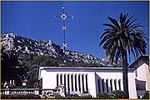Matisse and the Chapelle du Rosario de Vence
 |
| Matisse, Vence's Chapel, 1951 (Image: Wikipedia) |
“But, why do you even do this kind of things?” Picasso
asked this to Matisse when he found out about his friend’s project for the
Vence’s Chapel. Picasso was really angry. He was an atheist and communist; he respected
Matisse a lot but he couldn’t comprehend how he could work for a chapel not
being religious.
Actually, Picasso exposed a
common doubt then: can a non-believing artist paint religious scenes?
 |
| Matisse, Monique, 1942 |
It all started this way: Matisse had to go
through 2 operations against duodenum cancer to recover and flee away from
bombings, in 1941 he moved to Southern France. He was really weak and needed a
nurse to take care of him during the night. Monique Bourgeois, a young nursery
student, who needed to get some money to help her mother during the war, was
the chosen one. She liked to paint and Matisse wanted to teach her. She posed
for him some times, under her mother’s consent, and he painted her 4 times. She
helped him with gouaches for his book Jazz. Monique, meanwhile,
discovered her religious vocation. She tried to join the Clarisses but she was
rejected for her weak health. Finally, she was accepted by Vence’s Dominicans
under the name of Jacques-Marie.
Matisse disliked this decision much: “How could
you have such an idea?” After some time he understood that it was what made her
happy.
 |
| (Image: vence.fr) |
The convent’s chapel had been destroyed by a
fire. The sisters had always wanted to have it restored, but they didn’t have
the money. Jacques-Marie designed a stained glass of Virgin Mary, which Matisse
loved and made him get excited about the project. Brother Rayssiguier,
architect, was in charge of all the blueprints and structures. Brother
Couturier, booster of contemporary art in churches, helped them with the
theological subjects. The abbess did not approve for money shortage.
 |
| Matisse, Virgin Mary and the Child, 1951 |
But Matisse wanted to carry out the whole. So
he worked for free from 1949 to 1951, designing everything: the stained glass
windows, the Stations of the Cross, the chandeliers, the furniture, the
chasubles… He was already 80 years old and his health would get weaker, so he
could not handle with all the work. But then Jacques-Marie would always be
there willing to help. She meant the link between the artist, the superior, the
workers and the architect.
 |
| (Image: gliscritti.it) |
Matisse thought of some stained glass windows
that would reach the floor, in yellow, blue and green, having some fuchsia
shades when light hits. Walls were covered with white ceramic tiles, which
multiply the reflections of that ethereal light. They gave Matisse more than one single
struggle: Picasso contacted with his ceramists, the Madouras, but they had no
resources for this kind of work. They would be heated there and enameled in
Bourdillon. Matisse painted them with a large brush, before they’d get enameled
one more last time. The images are simple, drawn in black over white, as the
sisters’ habit.
 |
| Matisse, Sketches fot the Stations of the Cross, 1951 |
Meanwhile, in 1949 an exhibition was made there
to gather some money with all the drawings and models; in 1950, another one in
Tokyo. And MoMA afterwards asked for a copy of the chasubles. The Chapel was
blessed in 1951 dedicated to Our Lady of Rosary. Matisse could not assist.
Was Matisse a believer? Sisters insisted him it
was time already to fix everything with God, but he would reject. Jacques-Marie
comments in his book that she held a conversation with him about it the last
time they saw each other, but, of course, she does not specify anything about
it. Whenever he was asked if he ever abandoned his paganism, he’d answer that
his only religion was the love to the work he was going to create, which also
is present in the Chapel. He replied Picasso like this: “I don’t know if I have
or do not have faith, I might be Buddhist, working to be in a spiritual state
similar to prayer is what is essential.”
He considered this Chapel as the summit of his
career; he wanted that the visitors would go out relieved and purified.
He was offered to be buried in the Chapel, but
he rejected: it would have been an act of vainglory. He died in 1954.
Jacques-Marie died in 2005. Part
of the sketches and letters were donated to the Vatican Museums, where there is a hall dedicated to Matisse.
 |
| Matisse, Tabac Royal, 1943 |
Sources: Gilot, F. Matisse
und Picasso. München, Knaur, 1995
Matisse, H. Escritos y consideraciones sobre el arte.
Barcelona, Paidós, 2010
Soeur Jacques-Marie, Henri Matisse. La chapelle de Vence.
Nice, Grégoire Gardette Éd., 1993



No comments:
Post a Comment